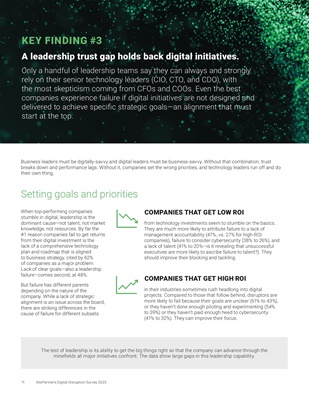
MIT CISR research found that top
performing companies - in profitability,
revenue growth, innovation, and agility
- attribute 10% more of overall firm
revenues to data monetization, as
compared to bottom-performers.
These companies appreciate that data
monetization - the conversion of data
into financial returns - can happen by
using data to:
1 improve work to do things better,
cheaper, and faster;
2 wrap products with analytics
features and experiences so that
customers pay more, buy more,
and stay longer; and
3 sell new innovative information
solutions to produce new
revenue streams.
On average 51% of data monetization
returns come from improving. For a
bank like BBVA, this means efforts
like optimizing their branches, which
generated 35 million dollars for the
bank in 2015. Of course, on average,
then 49 percent of data monetization
returns come from wrapping and selling.
For BBVA, this means increasing bank
customer retention and wallet share
by offering features like transaction
forecasting as part of personal finance
manager app, and selling access to
anonymized payment data through a
service called Paystats.
Monetizing data in both top-line
and bottom-line ways requires that
companies first transform data into
data assets that can be reused and
recombined for new - and diverse
kinds of - value creation. The easier
the reuse and recombination, the
higher the data's liquidity.
• Global packaging company Amcor
built a product specification
data asset that captures the
complex recipes for making the
company's products. Beyond
its use in manufacturing, people
across Amcor leverage the
product specification data for
analyses such as supplier risk,
regulatory compliance impact, and
sustainability reporting.
• Multinational beverage, retail,
and logistics company FEMSA
created a dead net profit (DNP)
data asset that transparently and
understandably demonstrates
SKU-level profitability for the
company's OXXO convenience
store chain. DNP is a financial
metric that calculates SKU-level
revenues and costs, accounting
for every business activity, to
arrive at a true measure of profit.
OXXO is now using the DNP data
asset in many areas, such as store
management, merchandising,
assortment, and operations.
• BNP Paribas created a proprietary
environmental, social, and governance
(ESG) scoring framework to quantify
a company's performance on material
ESG issues relative to peers. This
initiative was particularly compelling
because of the company's overall
strategic emphasis on using ESG
considerations to inform investment
decisions. The framework is fueled by
underlying strategic ESG data assets.
BNP Paribas also now uses this
exclusive ESG performance score to
inform a host of investment decisions.
The beauty lies not in a
single data monetization
initiative, but in the
recurring reuse and
recombination of
the carefully curated
underlying strategic
data assets.
For BNP Paribas, it's easy to imagine
myriad work processes that can be
improved, customer experiences that
can be enhanced, and new market
offerings that be innovated using the
company's strategic ESG data assets.
https://cisr.mit.edu/publication/2023_0501_InternalDataSharing_BradleyWixomBeath
https://cisr.mit.edu/publication/2021_0501_DataLiquidity_WixomPiccoli
https://cisr.mit.edu/publication/2021_0401_DataHeartsMinds_WixomOwensBeath
https://cisr.mit.edu/publication/2020_0401_DataMonPortfolio_WixomFarrellOwens
Data monetization: A new revenue source
We asked MIT CISR to share what leading companies from their research do differently.
AlixPartners Disruption Index 2023 15